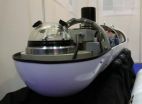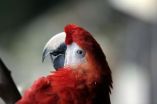"A common misperception among policymakers and individual agencies is that collaboration on these missions will save money or somehow boost capabilities," said D. James Baker, director of the global carbon measurement program at the William J. Clinton Foundation and co-chair of the committee that wrote the report. "However, multiagency partnerships generally have just the opposite effect and drive up overall mission costs because of schedule delays, added levels of management, and redundant administrative processes."
The committee examined case studies from previous domestic and international missions, received briefings from several agencies, and drew upon committee members' own experiences to reach its conclusions. While there are varying amounts of cooperation among agencies, the report says that generally the more interdependent agencies are for mission success, the higher the degree of complexity and risk associated with the project.
The report notes that while an agency will often enter into a partnership because its individual share of the mission is made more affordable, the risks involved in meeting schedules and performance objectives are typically underestimated. International collaboration suffers from the same increase in cost and complexity; however, the partnership can decrease U.S. costs because a foreign government absorbs some of the expenses. The report also notes that international collaborations typically receive much more planning upfront to define clear roles and responsibilities consistent with each entity's strategic plans.
"In many cases, an individual agency would do well to consider alternatives to full partnerships and instead buy specific services or coordinate spaceflight data from other agencies," said Daniel N. Baker, director of the Laboratory for Atmospheric and Space Physics at the University of Colorado, Boulder and co-chair of the committee. "However, if full collaboration is deemed to be warranted, then the agencies must take special care to ensure that disciplined attention to systems engineering and best practices for project management are followed."
If the Office of Science and Technology Policy, Office of Management and Budget, or Congress wants to encourage a particular interagency research collaboration, then it should provide specific incentives and support for these missions such as protecting interagency projects or providing freedom to move necessary funds across appropriation accounts, the report says. There is a need for coordinated oversight of interagency collaboration; however, OMB and OSTP are not suited to day-to-day oversight. Some alternative governance mechanism may be required to facilitate accountable decision-making across multiple agencies.
The report recommends criteria that should be met by agencies to jointly pursue earth and space science missions. Partnerships should add significant scientific value that could not be achieved by a single agency; utilize unique capabilities housed within an agency that are necessary for the success of a mission managed by another agency; help facilitate the transition from research to operations if these functions require a change in responsibility from one agency to another; or meet a compelling need such as building capacity at a cooperating agency. The report also recommends key elements to incorporate in every interagency collaboration.
The report also examines long-standing problems associated with partnership between NASA and the National Oceanic and Atmospheric Administration in support of climate research. It concurs with a previous Research Council report that recommends action by an executive branch entity above the agency-level to correct mismatches of authority and responsibility, inconsistent mandates, and budgets that are not well suited for emerging needs.
###
The study was sponsored by NASA. The National Academy of Sciences, National Academy of Engineering, Institute of Medicine, and National Research Council make up the National Academies. They are private, nonprofit institutions that provide science, technology, and health policy advice under a congressional charter. The Research Council is the principal operating agency of the National Academy of Sciences and the National Academy of Engineering. For more information, visit http://national-academies.org. A committee roster follows.
Contacts:
Molly Galvin, Senior Media Relations Officer
Luwam Yeibio, Media Relations Assistant
Office of News and Public Information
202-334-2138; e-mail news@nas.edu
Pre-publication copies of Assessment of Impediments to Interagency Collaboration on Space and Earth Science Missions are available from the National Academies Press; tel. 202-334-3313 or 1-800-624-6242 or on the Internet at http://www.nap.edu. Reporters may obtain a copy from the Office of News and Public Information (contacts listed above).
NATIONAL RESEARCH COUNCIL
Division on Engineering and Physical Sciences
Space Studies Board
Committee on Assessment of Impediments to Interagency Cooperation on Space and Earth Science Missions
D. James Baker (co-chair)
Director
Global Carbon Management Program
William J. Clinton Foundation
New York City
Daniel N. Baker 1 (co-chair)
Director
Laboratory for Atmospheric and Space Physics
University of Colorado
Boulder
David A. Bearden
Principal Director of NASA Programs
Aerospace Corp.
Pasadena, Calif.
Charles L. Bennett 2
Professor of Physics and Astronomy
Johns Hopkins University
Baltimore
Stacey Boland
Senior Systems Engineer
Earth Mission Concepts
Jet Propulsion Laboratory
Pasadena, Calif.
Antonio J. Busalacchi Jr.
Professor and Director
Earth System Science Interdisciplinary Center
University of Maryland
College Park
Carlos E. Del Castillo
Assistant Research Professor
Department of Earth and Planetary Sciences
Johns Hopkins University
Laurel, Md.
Antonio L. Elias 1
Executive Vice President and General Manager
Orbital Sciences Corp.
Dulles, Va.
Margaret Finarelli
Senior Fellow
Center for Aerospace Policy Research
George Mason University
Falls Church, Va.
Todd R. La Porte
Professor of Political Science
University of California
Berkeley
Margaret S. Leinen
Head
Climate Response Fund
Alexandria, Va.
Scott N. Pace
Director
Space Policy Institute, and
Professor
Elliott School of International Affairs
George Washington University
Washington, D.C.
Graeme L. Stephens
Professor
Department of Atmospheric Sciences
Colorado State University
Fort Collins
Annalisa L. Weigel
Assistant Professor of Aeronautics and Astronautics
Engineering Systems Division
Massachusetts Institute of Technology
Cambridge
Michael S. Witherell 2
Vice Chancellor for Research
University of California
Santa Barbara
A. Thomas Young 1
Executive Vice President
Lockheed Martin Corp. (retired)
Onancock, Va.
RESEARCH COUNCIL STAFF
Art Charo
Study Director
1 Member, National Academy of Engineering
2 Member, National Academy of Sciences
END




